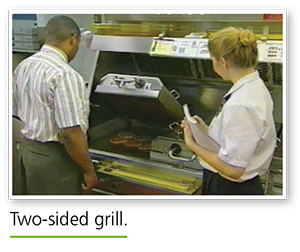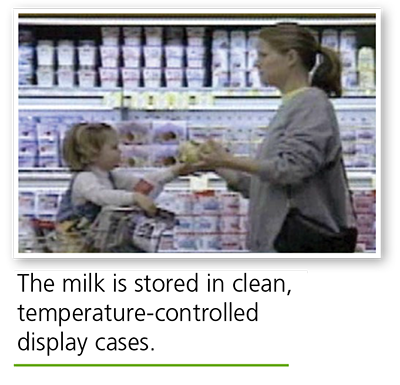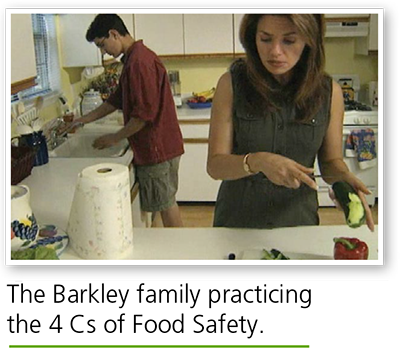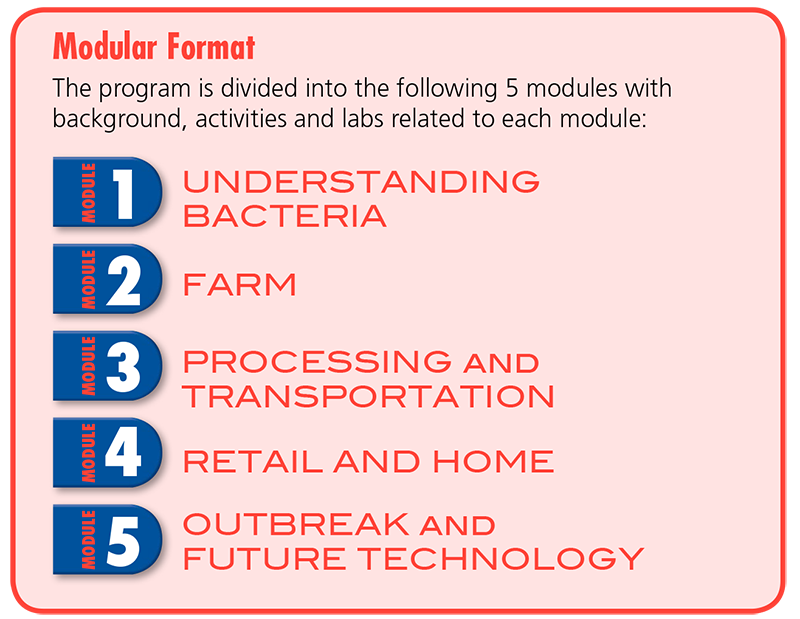Agricultural Literacy Curriculum Matrix
Lesson Plan
Fast-Food Footwork
Grade Level
9 - 12
Purpose
Students will explore how retail foodservice establishments ensure that food is safely stored, prepared, and served. Through inquiry they will also learn about local health regulations and how the 4 Cs of Food Safety apply to all aspects of foodservice. Grades 9-12
Estimated Time
45 minutes
Materials Needed
- Assorted materials for students to prepare class presentations
- Food Safety Checklist for Students Working in Foodservice Establishments, one for each student
- Dr. X and the Quest for Food Safety video, Module 4 — Retail and Home, Part 1
Vocabulary
food safety: the practice of handling, preparing, and storing food in a way that prevents food-borne illness
Background Agricultural Connections
Students eat and often work in all types of foodservice establishments. Exploring all the aspects of safe food handling in a retail situation helps make them better consumers and employees.
Retail Food Safety
The 4 Cs Connection — In any restaurant or place that serves food, the 4 Cs are critical. Sometimes, the 4 Cs can be taken care of by technology.
 Hi-Tech Hamburgers – Fast-Food Technology
Hi-Tech Hamburgers – Fast-Food Technology
To eliminate human error, an engineer developed a 2-sided “clam shell” type grill that has a temperature sensor. It cooks burgers on both sides simultaneously, using a sensor to ensure that all of the burgers reach a safe internal temperature.
Important Note: The “clam shell grill” is only one way to ensure safer food. Other methods, such as cooking on a grill and flipping burgers, are also effective. The point is to ensure that foods are cooked to a high enough temperature to kill any pathogens.
Handwashing
Humans are one of the biggest sources of food contamination in restaurants. So, proper handwashing is critical to keep food safe. For example, contamination can occur when someone doesn’t wash his or her hands and then prepares or serves food.
 Supermarkets
Supermarkets
Receiving areas are maintained at cold temperatures of 41° F (5° C) or below to maintain the cold chain that started way back in the field.
Storage areas and display cases are kept clean and temperature controlled.
Food preparation areas are also kept clean, and are set up to avoid cross-contamination.
Foods are always separated to avoid cross-contamination. Red meats, fish, and poultry will never be mixed together or mixed with fruits and vegetables.
Food Safety at Home
Even with all the great technology, food can still become contaminated, so it’s important for YOU to always practice the 4 Cs of Food Safety. Once you purchase food and take it home, the responsibility for food safety is literally in your hands.
 Overview of 4 Cs in the Home
Overview of 4 Cs in the Home
Clean — Wash hands and surfaces often. Wash hands with warm, soapy water, and cutting boards, dishes, utensils, and surfaces with hot, soapy water before and after food preparation.
Cook — Cook foods to proper temperatures. Using a food thermometer is the only reliable way to ensure that hamburgers, meat, and poultry reach a safe internal temperature.
Chill — Refrigerate promptly. Refrigerate or freeze foods quickly because cold temperatures keep harmful bacteria from growing and multiplying. Follow the 2-Hour Rule: Refrigerate or freeze perishables, prepared foods, and leftovers within 2 hours or less.
Combat Cross-Contamination (Separate) — Keep raw meats, poultry, and seafood — and the juices from raw foods — away from other foods in your shopping cart, on kitchen counters, and in your refrigerator.
 Science and our Food Supply
Science and our Food Supply
This lesson was developed as a portion of an entire unit of lessons focusing on food safety from farm to table. Use the following links to see the remaining lessons:
Module 1: Bacteria
Module 2: Farm
Module 3: Processing and Transportation
- Blue's the Clue: Souring Milk for Science
- Mystery Juice
- Irradiation Web Quest
- Ultra High Pressure Treatment
Module 4: Retail and Home
- Fast-Food Footwork
- Cooking Right: The Science of Cooking a Hamburger
- Coliform Counts
Module 5: Outbreak and Future Technology
Evaluation: Lose a Million Bacteria (The Game)
Engage

- Explain to students that Today we’re going to join Dr. X and become FBI (FoodBorne Illness) Investigators. We’ll be searching out how workers keep our food safe in the places we eat. Let’s start by thinking about the different kinds of places that we eat food. "Where have you eaten in the past 2 days?"
- List all the places the students mention. Then ask, "Where else is food served?" Encourage students to think of as many places as possible (school cafeteria, fast-food restaurants, street vendors, state fairs, sports events, rodeos, salad bars, delis, etc.).
- "How do you think these places make sure our food is safe to eat?"
Explore and Explain
- Divide the class into teams of 3 to 4. Have each team select a food establishment.
- Ask each team to develop a game plan to ensure that the food in their eatery is safe. If necessary, guide them to come up with some of the following actions:
- Research the food safety needs of your eatery such as:
- What types of food are prepared and served?
- Who are the typical customers?
- How is the safety of the food ensured …
- During storage?
- During preparation?
- After preparation and before serving?
- While serving?
- What happens to food that’s not used?
- How are employees trained in food safety procedures?
- How are cleanliness and handwashing standards maintained?
- Are there any unique machines or procedures the establishment uses to assure food safety?
- Who are the key people involved in monitoring food safety at your eatery (managers, health department authorities, health inspectors, etc.)?
- What role does food safety play in their daily jobs?
- Do customers have any responsibility for food safety?
- About the regulations and the inspectors:
- What do food inspectors look for when they visit a food establishment?
- What are the local, county, and state health regulations governing the food establishment?
- How do these health regulations relate to bacterial growth and its spread?
- How does the manager implement Hazard Analysis and Critical Control Point (HAACP) procedures (see Food Safety A to Z Reference Guide)?
- How does the manager implement the FDA Food Code (see Food Safety A to Z Reference Guide)?
- Research the food safety needs of your eatery such as:
- Using their findings, have students: Develop a food safety plan for their eatery that includes the 4 Cs of Food Safety. For each area of the eatery that deals with a “C,” there should be a science-based explanation of how that “C” helps keep the food safe.
- Plan a food safety training session for the employees of their eatery. Include a list of actions that the employees should follow. Give them the Food Safety Checklist to adapt to their eatery.
- Present their plan to the class, describing what their eatery needs to do to assure the safety of the food that they serve. Encourage students to be creative. For example, they might develop an innovative presentation using PowerPoint®, web pages, posters, skits, 3-D models, etc. Limit each presentation to 3–5 minutes.
- Identify the food safety practices that the eateries have in common. Are there any differences among the eateries? (Most practices will relate back to the 4 Cs of Food Safety: Clean, Cook, Chill, and Combat Cross-Contamination [Separate].)
- Prepare students for video clip by saying, "Let’s join Dr. X and Tracy as they take us behind the scenes at fast-food eateries and supermarkets. Tune in, and take notes.
- Dr. X showed us many examples of how restaurants and supermarkets practice the 4 Cs. What were they?
- What does Dr. X imply when he says, “The responsibility for food safety is literally in your hands”?
- Show video Module 4, Part 1 — Retail (Time: 3 minutes).
Elaborate
-
Design an innovative “Be Sure to Wash Your Hands” sign to post in the rest rooms in your school.
-
Trace a food through a fast-food restaurant. How is it kept safe until you purchase it? How is it touched and by whom? Is there a way to ensure that everyone who touches the food has clean hands?
-
Interview local health department officials and health inspectors. Ask them about their careers and how they use their science backgrounds in their daily jobs.
Evaluate
Have students summarize what they’ve learned during their FBI Investigation. Ask them to relate what they’ve learned in other modules to food safety in retail food establishments. Some probable responses include:
- There are many systems and regulations in place that guide retail establishments in preventing foodborne illness.
- Food safety is a major part of a retail food establishment’s operations. Because they might also be the final link in the farm-to-table continuum, retail establishments play an integral part in keeping our food safe.
- Handwashing is one of the most important things an employee can do to prevent foodborne illness.
- Health department professionals are scientists and food safety detectives.
- Every employee in a foodservice operation has responsibility for food safety.
- Customers have a responsibility for food safety after they purchase the food.
- If/when I work in a food service job, I need to carefully follow safe food handling and cleanliness practices.
Summarize that food safety is an important aspect of retail food establishments. There are strict science-based regulations governing foodservice. Everyone at the food establishment has responsibility for food safety — managers and all of the employees. Customers are responsible for the safety of their food once they purchase it and take it home.
Acknowledgements
The Science and Our Food Supply Curriculum was brought to you by the Food and Drug Administration Center for Food Safety and Applied Nutrition and the National Science Teachers Association.
- FDA Education Team Leader Food Safety Initiative: Marjorie L. Davidson
- FDA Science and Our Food Supply Project Director: Louise H. Dickerson
- FDA/NSTA Associate Executive Director and Science and Our Food Supply Program Director: Christina Gorski
- FDA/NSTA Science and Our Food Supply Program Assistant: Jill Heywood
Recommended Companion Resources
Author
FDA and NSTA
Organization
FDA and NSTA
| We welcome your feedback! If you have a question about this lesson or would like to report a broken link, please send us an email. If you have used this lesson and are willing to share your experience, we will provide you with a coupon code for 10% off your next purchase at AgClassroomStore. |
